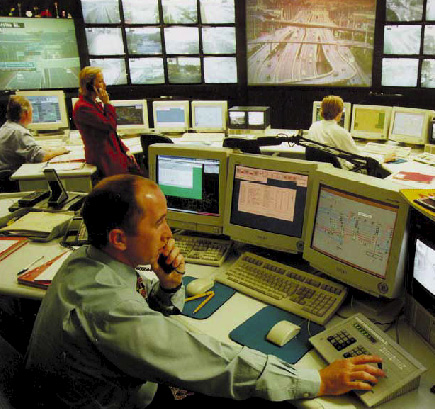
| Previous | Home | Next |
Contents
Intelligent Transportation Systems
The Development of transportation in the UK over the past 100 years has contributed enormously to the mobility of ordinary people on a scale unimaginable to past generations. It has also contributed to the prosperity of the country by assisting the efficient manufacture and distribution of goods and by allowing people a wider choice of employment opportunities. However, there is a downside. Congestion, wasted energy, traffic accidents, pollution, these are all too often associated with today’s transportation infrastructure - and everyone suffers as a result. For years, the government has sought to solve some of these problems by merely building more roads. Pouring additional asphalt and concrete added capacity but did not address the underlying problems of our transportation system.
As a group we were interested in examining what impact the introduction of technology in both road charging and more sophisticated vehicles would make - could it offer a more sustainable solution? This approach, which is characterised by the three features of communications, integration and information, goes by the generic title of Intelligent Transportation Systems (ITS) technology.
WHAT IS ITS?
Electric traffic signals, that could be considered the original ITS, have been around since the 1930s when the first electric powered traffic signals were installed in Cleveland, United States. The Japanese are credited with initiating the modern day notion of ITS with the work carried out in the 1980s. But the actual term ITS was coined by the United States and has now been adopted by most international organisations.
Generally, ITS refers to a broad range of diverse technologies applied to transportation to make systems safer, more efficient, more reliable and more environmentally friendly, without necessarily have to physically alter existing infrastructure.
CATEGORIES OF ITS
There are many applications to ITS and they can by classified in many different ways, one of the most straightforward ways is by “market area” (McQueen B. 1999). Area 1: Traffic Management Area 2: Emergency Management Area 3: Transportation Planning Area 4: Traveller Information Area 5: Commercial Vehicles Area 6: Transit Management Area 7: Intelligent Vehicles Area 8: Incident Management Area 9: Payment Systems
ITS IN GLASGOW
Glasgow is currently benefiting from ITS technology in two areas: Traffic management and traveller information through use of the National Driver Information and Control System (NADICS). NADICS was launched in 1996 and is capable of covering all of Scotland. The system allows real-time information about incidents and congestion to be passed to drivers using variable message signs. NADICS can also be readily configured to accommodate future traffic control techniques. For example, ramp metering and dynamic integration with Glasgow’s CITRAC system are already included within NADICS.

Figure 1: The National Driver Information and Control System based in Glasgow helps make travelling by road a little agreeable
In this project we concentrated on two specific areas of ITS: intelligent speed adaptation and toll charging, both of which we set in Glasgow. (Although toll charging may not seem at first glance to be very “intelligent” in the electronic sense of the word, our system did rely on modern electronic and software technology and so it is classed as an ITS). We aimed to demonstrate how the successful deployment of these ITS has the potential to vastly improve transpiration in Glasgow. Navigate through our sections to uncover our findings.
Top© 2004 All rights reserved. Copyright of Derek Weir, Leanne McMillan, Roy MacLean, Hee Dong Oh & Ayman Elsadig
| Previous | Home | Next |